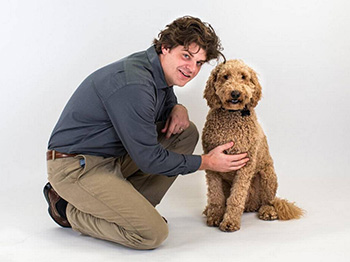Is Your Dog A Genius?
Dr. Brian Hare - NAT GEO WILD
 Nat Geo's Dr. Brian Hare was the host a three-part series devoted to finding the genius in your dog with interactive games you can play. Tapping into your dog's 'smarts' is easy as knowing the activities in which they exceed.
Nat Geo's Dr. Brian Hare was the host a three-part series devoted to finding the genius in your dog with interactive games you can play. Tapping into your dog's 'smarts' is easy as knowing the activities in which they exceed.
Dr. Brian Hare, founder of the Duke Canine Cognition Center, was the host of the new NAT GEO WILD Show, "Is Your Dog A Genius?"
Dogs live in your home. They know your most intimate secrets. They know your smell! But how well do you know that stranger sleeping in your bed? Dr. Brian Hare has spent his life tracking down clues to the remarkable bond between humans and canines. He then developed a groundbreaking series of scientific tests to see just how well you know your dog.
The great and fun thing about the show was that it had a participatory component. With most TV shows, you watch and learn and that's it. But this show on NAT GEO WILD, "Is Your Dog A Genius?" allowed you to not only see the best science and learn what the best science revealed about dogs, but it also told you how you apply it to your own dog at home. This was not homework, but fun and games which allowed you to have an even better relationship with your dog and understand how they think.
Are there certain dogs that are smarter than others? Are there certain dog breeds as a whole, which are smarter than other breeds? These questions are why NAT Geo decided to do this show. If everyone who had a dog watched this show and in return participated, then people with different dog breeds would have contributed data that allowed these questions to be answered.
 This show was not about whether or not dogs are smart, but to reveal what science has shown, which is that there are different types of intelligence in dogs and different dogs have different ways of solving problems.
This show was not about whether or not dogs are smart, but to reveal what science has shown, which is that there are different types of intelligence in dogs and different dogs have different ways of solving problems.
The show showed dogs that were incredible communicators; dogs that had amazing empathy; and even dogs that were capable of inference. However, it doesn't mean that each individual dog did all these three things.
One thing that was learned about dogs is that just like human infants, dogs when they lock gaze with us, are actually releasing the same hormone that leads to bonding between a human and infant when a baby is first born. This is interesting, because we have all heard that making eye contact with dogs is threatening to them.
Visit Website
Pheromones In Puppy Training - Dr. Debbie
 So you just got a new puppy and you have all your training tools at the ready, the collar, leash and dog crate. But beyond that, do you have the one thing that can make your training tasks easier all around? Tap into your puppy's own sense of smell using canine pheromones and ease your new pup's training and transition into the home.
So you just got a new puppy and you have all your training tools at the ready, the collar, leash and dog crate. But beyond that, do you have the one thing that can make your training tasks easier all around? Tap into your puppy's own sense of smell using canine pheromones and ease your new pup's training and transition into the home.
Pheromones are scent signals emitted by all animal species, including humans. Various pheromones work under the radar to influence the perceptions and behaviors of others within a species.
Shortly after whelping, a pheromone is emitted from the bitch's sebaceous (oil) glands located between the mammary glands. The pheromone, dubbed the canine appeasing pheromone, reassures the puppies, calms them and facilitates nursing. The bitch stops emitting this pheromone as the pups mature, but all dogs retain the ability to "read" this pheromone. Not only do older dogs recognize this pheromone, but it continues to have a natural calming effect on canines of all ages.
In veterinary behavior cases, the dog appeasing pheromone is used for dogs with noise phobias, car travel anxiety, separation anxiety and other fearful situations. Various forms are available including pheromone collars, plug in diffusers and sprays. The canine appeasing pheromone doesn't sedate the dog; rather it decreases fear and excitability.
The dog appeasing pheromone is also helpful for newly adopted puppies. Those first few days to weeks in a new home are full of changes for the pup faced with novel environments far from the comfort of mother and siblings. The dog appeasing pheromone has been shown to ease the transition of the pup into new home and improve sociability and training during a pup's critical socialization period.
Pheromone Research
For skeptics that need to see the proof in the studies, veterinary behavior studies have examined the positive influence of the dog appeasing pheromone. When comparing treatment responses for dogs with separation anxiety, the use of the dog appeasing pheromone equaled the benefit of the anti-anxiety medication, amitriptyline.
One study looked at 66 puppies as they settled into new homes after adoption. Approximately half of the puppies wore a pheromone collar and half wore a placebo. The study found that puppies wearing a pheromone collar displayed significantly fewer nuisance behaviors like vocalizations or scratching within 3 days of adoption. Pups wearing the pheromone collar woke their owner's less during the night and displayed fewer signs of distress and vocalizations throughout the course of the study.
The researchers concluded that pheromone collars helped both the pup and family. Pups were less stressed and adapted easier. By decreasing the pup's stress and fearful behaviors, the pet owners found a more enjoyable bonding experience with the new pup and faced less frustration through the training process.
 In another study, puppies 8 to 15 weeks were enrolled in an eight-week long puppy socialization and training class. Half wore a pheromone collar and the other half wore a placebo collar. The pups wearing the pheromone collar were calmer in the face of novel experiences and displayed less fear, anxiety, and aggression. In the end, the pups with the pheromone collar not only were less nervous, but had fewer behavioral problems and learned better. And a long-term effect on sociability was recognized in dogs up to one year after the class and study was completed.
In another study, puppies 8 to 15 weeks were enrolled in an eight-week long puppy socialization and training class. Half wore a pheromone collar and the other half wore a placebo collar. The pups wearing the pheromone collar were calmer in the face of novel experiences and displayed less fear, anxiety, and aggression. In the end, the pups with the pheromone collar not only were less nervous, but had fewer behavioral problems and learned better. And a long-term effect on sociability was recognized in dogs up to one year after the class and study was completed.
Pheromones and My Pup
As a previous owner of a nine-week old Bouvier puppy named Nikki, I used both the pheromone collar and diffuser upon welcoming my new pup home. One day before bringing Nikki home, I placed a pheromone diffuser close to the puppy crate, where it would have maximum benefit during her first nights in the kennel away from mother and siblings. Immediately upon leaving the breeder's home, Nikki was fitted with a pheromone collar to serve as a source of reassuring pheromones that went everywhere she did. The pheromone collar became a tool in Nikki's socialization. It was on her when she met new people or animals, when she explored new environments and during puppy kindergarten class.
Did pheromones help in my pup's transition and training? The four hour drive home from the breeders was a dream, no crying or whining the entire trip. After returning home, Nikki never soiled in her kennel during the day or night. I'll admit I had my share of interrupted sleep in the first two weeks, but most of Nikki's night time wakes were for genuine elimination needs. Overall, her transition into the home was smooth and lacked the wailing, inconsolable cries of a stressed pup.
The canine appeasing pheromone isn't a magic bullet though. Nothing matches a quality pup obtained from a reputable breeder who focuses on health, genetics and early socialization. Likewise, pheromones do not replace the hard work and consistent training efforts that any new pet owner must provide. However, by adding the the canine appeasing pheromone to your new puppy training, you can help your pup become the best he or she possibly can.
Featured veterinarian known as "Dr. Debbie" on national pet radio program, Animal Radio. Ebook author of "Yorkshire Terriers: How to Be Your Dog's Best Friend"; "Pugs: How to Be Your Dog's Best Friend"; "Mini Schnauzers: How to Be Your Dog's Best Friend"; and "Shih Tzu: How to Be Your Dog's Best Friend." Dr. Debbie's books.
Visit Website
 Animal Radio News - Tammy Trujillo
Animal Radio News - Tammy Trujillo
It's Not Our Fault That We Consider Our Pets Our 'Babies'
A study shed some light on why our emotional attachment can be so strong with our pets. Research done at the Azabu University in Japan said the connection was comparable to the actual bonding between a parent and infant. It has to do with the hormone called oxytocin, or the cuddle chemical. It's produced in the brain and encourages bonding. Previous studies showed it works human-to-human and even dog-to-dog, but this study was the first to show the hormonal bonding between people and dogs. In the study, pet guardians and their dogs gazed at one another resulting in increased oxytocin. In the second part, researchers dosed dogs with either a spray of saline or oxytocin in the nose. The female dogs treated with oxytocin spent more time gazing at their guardians, which after 30 minutes boosted the levels of their peoples' oxytocin.
Medical Marijuana For Pets Is Available In Texas
You have to go online, but you can buy capsules, treats and other marijuana edibles as natural pain relievers for your pets in Texas. Because they contain such a low percentage of THC, the chemical responsible for most of marijuana's psychological effects, they're legal. Veterinarians cannot prescribe cannabis products to pets, they can only recommend them. At least one veterinarian has spoken out about the issue, saying there is no proof that medical marijuana can help pets and no research on whether it can harm them. He says the biggest concern is that the availability of medical marijuana for pets amounts to them being used as guinea pigs. The FDA investigated the benefits of the products.
 Service Pit Bull Allowed to Attend School
Service Pit Bull Allowed to Attend School
This was a big win for the rights of service animals and for the people who rely on them so very much. A federal judge in Florida ruled that a sweet pit bull was allowed to go to school with a child who had cerebral palsy. The dog did a lot of things for the child, like alert a grown-up when something was wrong and just kept him company and comforted him. Originally, the school refused to let the dog come to school with the child, unless the company paid for a so-called handler to go with them, which the family could not afford. After a long legal battle, a U.S. District Judge sided with the dog and the child. Under the Americans with Disabilities Act, schools aren't allowed to separate people from their service animals. The ruling in this case would set a precedent when other schools challenge that rule.
San Francisco Bans Wild and Exotic Animal Acts
When the circus comes to San Francisco next time around, it won't feature any wild or exotic animal acts. San Francisco banned such animals from performing. The ban covers exotic animals used in entertainment, everything from elephants and lions to seals and ferrets and applies to more than just circuses. It includes the motion picture industry, meaning no films made in San Francisco can feature wild animals. Other major cities across the U.S. have passed laws that effectively keep exotic animals out of circuses. Los Angeles, Austin and Oakland have banned the use of bull hooks, or sharp metal sticks used to control elephants, which are needed to coerce elephants into performing. And in other countries, Austria, Croatia, Greece, Malta are among those that have all passed nationwide bans on performing exotic animals in circuses.
 Listen to the entire Podcast of this show (#1217)
Listen to the entire Podcast of this show (#1217)





